B2B Social Listening: Ultimate Guide for 2026 + Use case
Table of contents
In 2025, B2B companies face new challenges. According to Gartner, 80% of B2B sales interactions between suppliers and buyers will happen online. With AI all around, real connections, tailored messaging, and establishing actual relationships with customers and partners are a must. But how to do it?
In this guide, I’ll show you how modern social listening tools can transform your B2B marketing, sales, and product strategies with insights your competitors are likely missing.
Let’s begin!
Quick summary:
– B2B social listening is a process that empowers your team to get real-time insights from digital conversations, analyze sentiment, track competitors, and identify key trends.
– B2B social listening tools go beyond monitoring likes and mentions and offer various advanced analytics and AI insights.
– Done right, social listening fuels smarter marketing, proactive brand management, better-tailored PR, and product development decisions.
What is B2B Social Listening?
B2B social listening is the process of tracking, analyzing, and driving insights from digital conversations that matter to your business.
According to Social Media Today, more than 82% of professionals consider it a key planning element.
Try B2B social listening!
This process can include monitoring conversations about your brand, specific products you launched, your own hashtag, or your competitors online.
And by online, I really mean the whole web. Social listening tools cover a lot of various sources.
For example, Brand24 provides data from:
- Social media platforms (Instagram, Facebook, TikTok, X (Twitter),
- Forums
- News
- Podcasts
- Blogs
- and more!
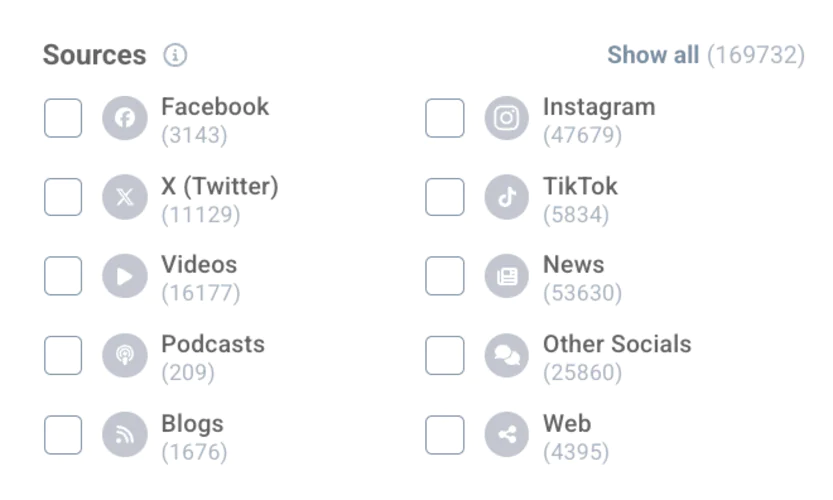
Some people confuse it, so I feel the need to explain: What’s the difference between social listening and social monitoring?
- Media monitoring simply tracks metrics like tags, mentions, and engagements.
- Social listening digs deeper to interpret context and sentiment, recognize patterns, and recommend action.
How does it change for B2B and B2C?
In B2C, it’s often about brand image or product promotion.
In B2B, it’s about understanding complex decision-making processes, longer sales cycles, and industry-specific dialogue.
Improve your lead gen efforts!
What are the benefits of a social listening strategy for B2B?
Today’s buyers, especially in B2B, expect highly personalized, tailored experiences.
With complex decision paths and multiple stakeholders, real-time insights are not really optional – they’re essential.
Social listening is your team’s bridge between unstructured online conversations and a structured business plan tailored to your competitive landscape.
Adding it to your strategy can be beneficial for various parts of your business team.
Try an all-in-one tool for your team!
Here’s what benefits B2B social listening can bring for:
- PR people
Can easily find places where the business was mentioned (both positive and negative) and use this opportunity to find new partnerships or take care of a PR crisis before it escalates. They can also set real-time alerts to never miss the important stuff. - Marketing team
Can understand your target audience better, learn about their needs and challenges, and tailor their campaigns accordingly. They can also perform market research and benchmark against competitors. It gives a deeper understanding and allows improvements to build credibility and authority in niche industries. - Sales representatives
Can spot potential customers and boost their lead generation efforts, and improve customer retention by acting on feedback quickly. - Product team
Can anticipate customer concerns and product gaps. They can also set priorities for improvements and new updates.
Plus, all of the above groups can benefit from AI features, such as summaries of the brand’s performance or customizable reports.
Boost your business with AI features!
Here’s what experts say:
“Brand awareness is notoriously difficult to track, but using social listening tools to track brand mentions for your own brand—and even for competitors, partners, and trends in your market—is a great way to track your brand’s influence over time.”
– Emily Kramer, Marketing Advisor
Of course, the B2B segment also faces many other challenges.
So, what are they? And how can your team take care of them?
Here’s the list:
Challenges unique to the B2B market & how to overcome them
- B2B has longer, multi-touch sales cycles
Sales aren’t impulsive in the B2B segment. Buyers engage with multiple content pieces and conversations before converting.
Social listening can monitor these moments to help you understand where your leads are in the funnel and what they expect. It will also help you find the right time to reach out to your target market with your offer.
Reach your target with a more tailored message!
- Relationship > Transaction
In B2B, long-term trust matters more than flashy ads.
Social listening helps nurture these relationships by identifying pain points and proactively tailoring the message. It makes social customer service much more effortless and can help you connect with your online audience.
Establish a connection with your audience!
- Niche industry conversations
In B2B, valuable discussions often happen on more specialized forums or in industry-specific news, which sometimes are hard to find if you’re not a pro.
Tools like Brand24 ensure you don’t miss out on these deep-dive discussions and can help you track market trends.
Find the best places to talk to your niche!

- Need for precision
Basic brand mentions monitoring may not cut it in technical B2B contexts. Tools that use AI are great for analyzing online conversations.
The outcome: you easily spot emerging topics in the industry and what’s happening to your brand. Whether it’s on social media channels or far beyond.
Be one step ahead!
This is crucial to take care of your B2B customer satisfaction.
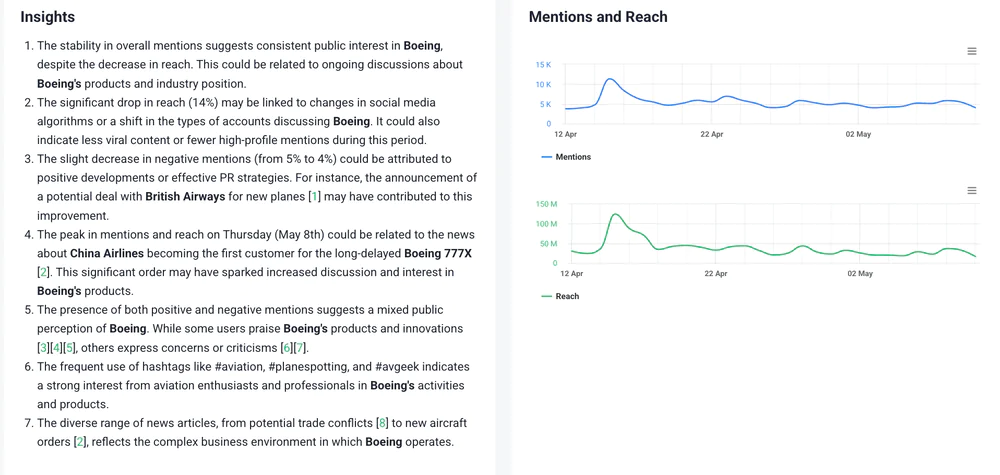
The challenges above are very specific to business-to-business. The next important thing would be choosing the right tool to help you with those challenges.
Try B2B social listening!
So, here’s what you should look for:
What features are essential for B2B social listening?
As the B2B market has its own challenges, it also has special needs regarding features.
Below, I have listed the most important features for B2B social listening:
- Advanced filtering
Makes it much more versatile.
Thanks to filters, the tool is useful for your whole team, not just a PR specialist or a marketer – everyone can apply the filters they need for their part of the business and benefit from the analysis.
Check how effective your team can be!
For example, the product team can easily filter the mentions to look for feedback about the recent update or new product:
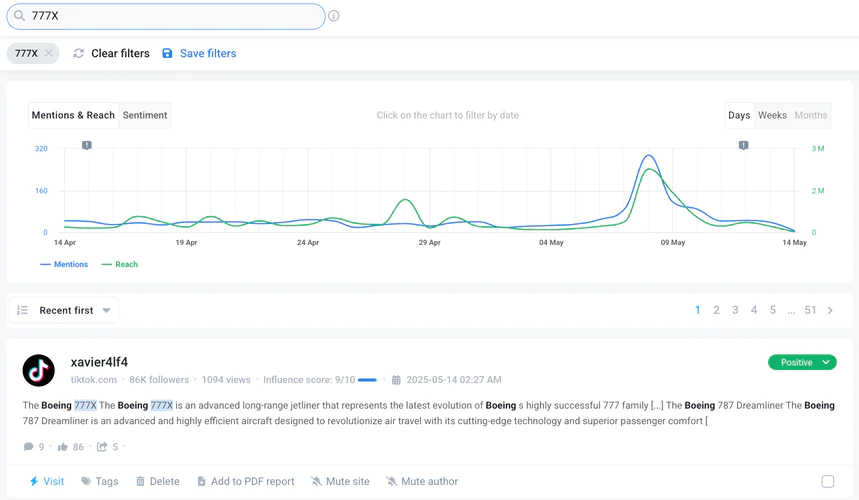
While the PR specialist can filter by sentiment to find negative comments and take care of them:
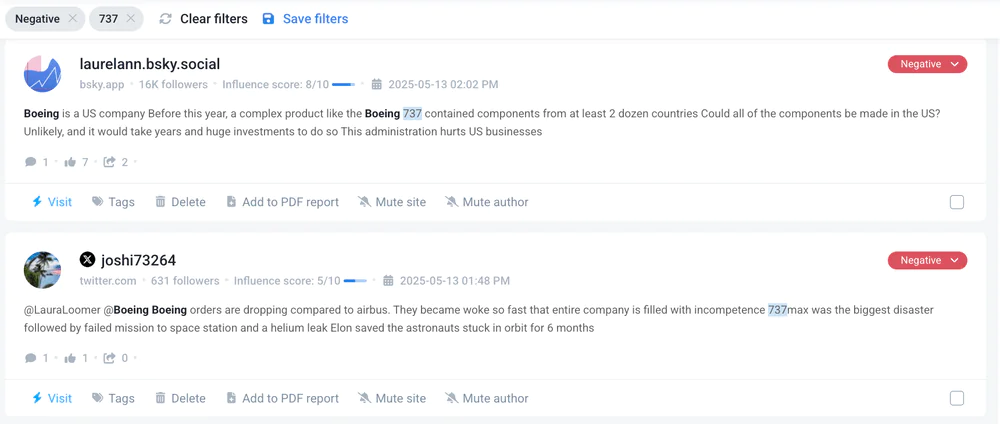
Want to see how it works in action? Check out this guide on PR sentiment analysis
- AI Analysis
AI features can speed up the analysis and give answers to nurturing questions within minutes. It’s a game changer to gain market intelligence.
For example, look at the AI Brand Assistant below.
You can ask it questions regarding your industry trends, performance, or competitors. Its answers are based on your project data and ChatGPT’s knowledge.
Try AI and save time and money!
Here’s an example: I asked about Boeing’s strengths and weaknesses compared to the competition:
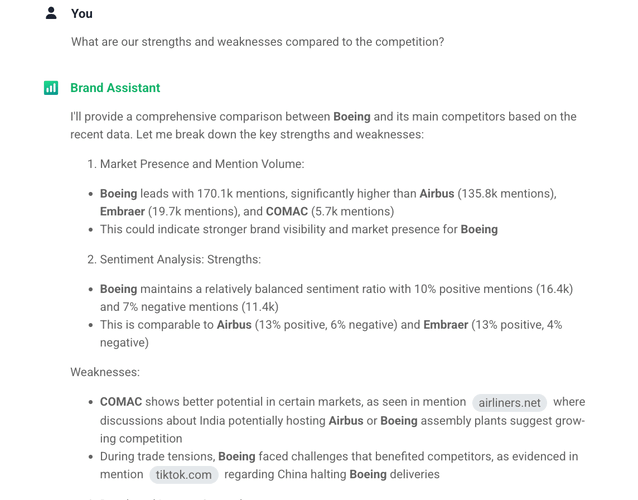
- Sentiment analysis
When big names in your industry talk about your company, it can change everything overnight and lead to a real PR crisis.
While regular consumer brands might recover from a few bad reviews, in the business-to-business world, a damaged reputation spreads like crazy.
Tools like Brand24 can spot early signs of negativity before small complaints turn into major public problems.
When you’re dealing with business contracts worth thousands or millions of dollars, knowing the mood of the market is a must.
It both protects your current client relationships and helps you spot new opportunities when your competitors mess up.
Know what people really think about your business!

- Sharable reports
Ever notice how the best teams seem to move as one? That’s no accident.
When you share reports across the company, your product developers actually hear customer feedback, and your sales team knows what potential clients look for.
Reports can include insights like:
- Key topics around your brand
- Your performance over the given period
- Most influential mentions about your brand
- What people think about your brand or specific product/marketing campaign
- and much more!
By getting everyone on the same page with these insights, you can spot problems and tailor your marketing messages before your competitors even notice them.
Spread knowledge where it should be!
Here’s an example of a shareable social listening report by Brand24:
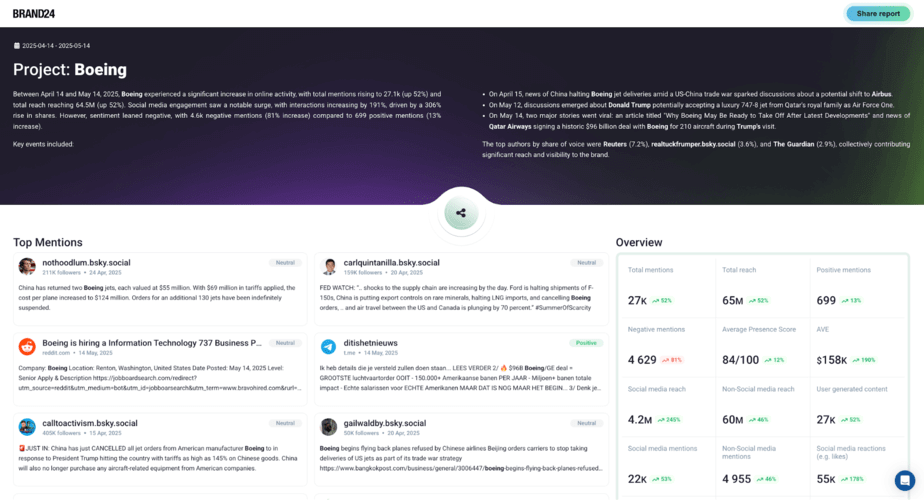
Pro tip: The people you share Brand24 reports with don’t have to be signed up – you can just share a link with anyone you need.
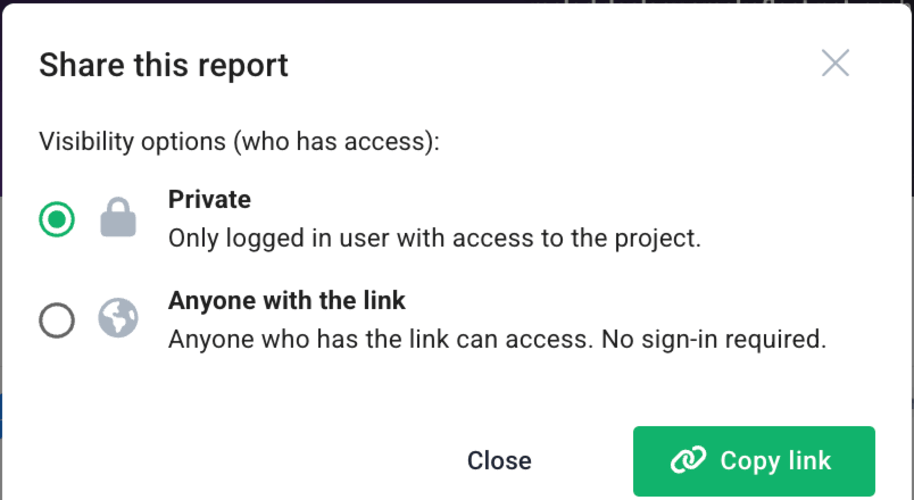
- Competitors comparison
This isn’t about copying them, it’s about spotting the gaps they’ve left wide open for you to step in and win those customers who aren’t quite satisfied with what they’re getting elsewhere.
The real power comes when you compare numbers side by side.
You might discover your competitors are crushing it on LinkedIn but completely missing the mark on industry forums where your actual decision-makers hang out.
Monitor your competitors!
Here’s the comparison for Boeing and its competitors:
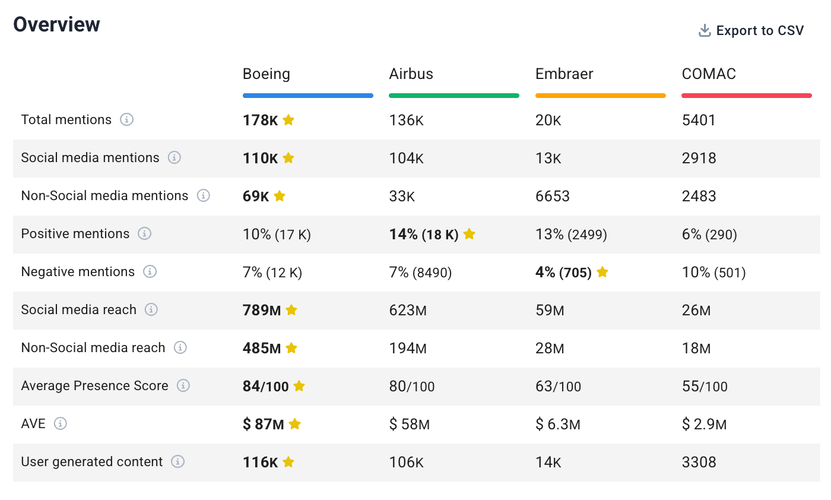
And a little pro tip from a B2B Marketing Advisor, Emily Kramer:
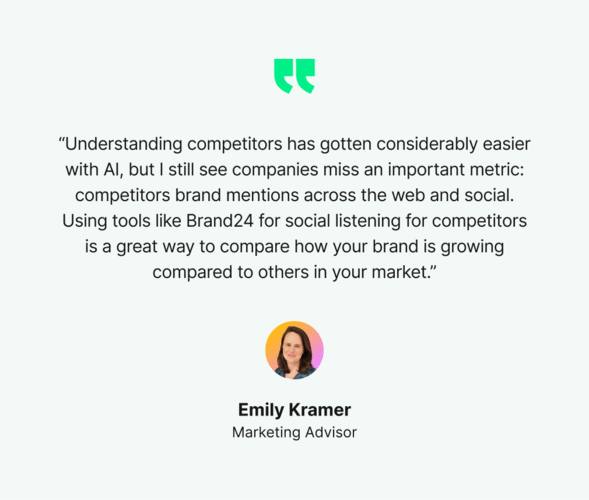
Tracking competitor mentions and addressing the needs in them can be a great way to promote your brand online and make more informed decisions based on industry insights.
Best practices for effective B2B social listening
As you probably noticed, social listening gives many possibilities to B2B businesses. Which is generally a plus!
But if you’re new to the game, it may also sound like a lot.
Try B2B social listening!
So, to make it easier, I curated a list of tips and best practices for your B2B social listening:
- Track competitors’ content, campaigns, and mentions. Learn from their wins and missteps and get valuable insights.
- Use AI to get actionable insights about your brand performance, audience, and competitors.
- Filter to relevant sources – prioritize LinkedIn, Reddit, industry forums, and even product review sites where professional discussions happen.
- Don’t just report the data. Let it shape product roadmaps, marketing campaigns, and customer service strategies.
- Find relevant influencers – use social listening tools to find influential people who are relevant to your industry and already talk about your business.
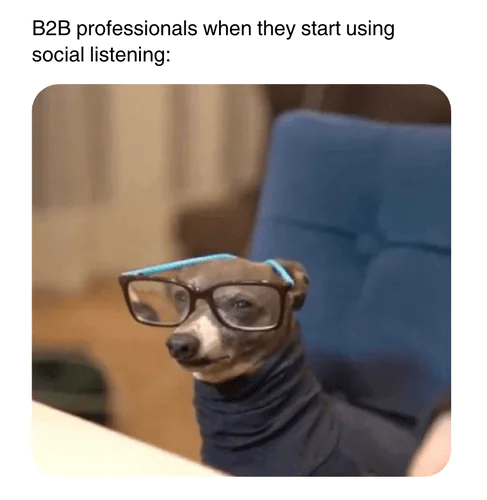
And to wake up your imagination a bit, here’s a fun B2B use case:
B2B Social listening use case
So, for some context:
In early 2024, Boeing was hit with a barrage of safety incidents:
- A 737 MAX door blew off during an Alaska Airlines flight, injuring passengers.
- A United Airlines 737 MAX experienced a flight control failure during landing.
- Another United flight lost a wheel during takeoff.
The public narrative spiraled quickly: Boeing was seen as disorganized, opaque, and unsafe. CEO Dave Calhoun decided to resign, and the company’s stock dropped by nearly 30% YTD.
And know…
Let’s say you’re a PR Specialist at Boeing (hehe)
You’re waking up to a news feed saturated with outrage, memes, and expert takedowns about Boeing.

Now what?
01 You don’t use social listening
You’re flying blind…
- You find out too late which incidents are going viral.
- Misinformation spreads unchecked.
- Reporters ask questions before you’ve even seen the source tweet.
- You’re relying on manual searches that take way too much time to proceed.
Outcome:
By the time your team reacts, public opinion is cemented. Your official statement sounds reactive and vague.
Media use phrases like “Boeing declined to comment in time.” and investors panic.
Work smarter, not harder!
02 You have a social listening strategy
You get alerts in real-time, and:
- Your dashboard is on fire, but you’re on time, and you easily spot which incident is escalating.
- You check the sentiment analysis for specific platforms and know where people are angry and what they say.
- You identify key mentions and any misinformation and respond before it snowballs.
- You monitor related discussions, understanding the mood among the community audiences, and tailor your message.
- You inform internal stakeholders fast, and they get the info from you, not the news.
Outcome:
You issue a transparent, human-centered statement within hours.
Your FAQ covers the exact concerns customers and journalists are raising. You post updates across social channels, link to investigations, and invite online chatter.
Investor confidence stabilizes. Journalists cite your transparency. You turn a crisis into a story of accountability and action.
Try B2B social listening!
Conclusion
So, are you still going to be ignoring social listening?
The question isn’t whether you can afford to invest in social listening.
It’s whether you can afford not to, while your competitors are already using it to win the customers you’re missing.
Key takeaways:
- B2B social listening can be beneficial for your whole team – PR pros, sales team, marketers, and product development.
- Social listening is great for understanding the social media landscape, monitoring trends, sentiments, and customer feedback.
- AI solutions can make complex analysis way faster and more effective.
Ready to stop guessing and start knowing what your market really thinks? Start with the Brand24 trial and take action!


